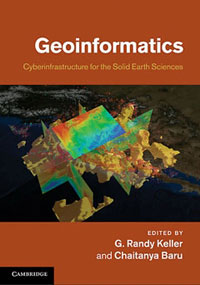

 Skip to navigation
Skip to navigation
Site Primary Navigation:
- About SDSC
- Services
- Support
- Research & Development
- Education & Training
- News & Events
Search The Site:

Published 05/25/2011

|
Called 'Cyberinfrastructure for the Solid Earth Sciences', the book is co-edited by G. Randy Keller, Professor and Edward Lamb McCollough Chair in Geology and Geophysics at the University of Oklahoma, and Chaitanya Baru, a distinguished scientist at SDSC. More information about the 388-page hardbound book, published by the British-based Cambridge University Press, can be found online.
Geoinformatics provides an informatics framework for scientific discovery through the integration and analysis of earth-science data and applications. As a result of significant work in this area, geoscientists now have at their disposal on-line data archives and databases, a variety of community-based software tools, and access to high-performance computers and other resources to address complex questions related to the structure, dynamics, and evolution of the solid Earth through time, as well as the processes that act upon and within it from the near surface to the core.
"The study of complex phenomena in earth, ocean, and atmospheric sciences all require on-demand access and integration of heterogeneous data from a wide variety of sources and disciplines. This is where cyberinfrastucture - an integrated, often Web-based network of computer resources and expertise - comes into play, helping geoscientists develop better and more refined models using a range of both small and large heterogeneous data sets," according to co-author Baru.
"Advanced data cyberinfrastructure is needed to provide these capabilities and to support geoscientific research and discovery in areas that affect us all, from natural resource studies and natural hazard assessment and forecasting to environmental monitoring and climate change studies, just to name a few," said Baru.
|
Chaitanya Baru, SDSC |
G. Randy Keller, U Oklahoma |
Six of the 24 chapters in the book are co-authored by SDSC researchers, whose contributions cover a range of topics. They include Sriram Krishnan (comparative cyberinfrastructure), Ilya Zaslavsky (hydrologic information systems), Chris Crosby and Vishu Nandigam, (high-resolution topographic data) and Amit Chourasia (advanced visualization).
"Today's high-performance cyberinfrastructure embraces what I like to call high-performance data, as today's researchers in earth sciences and other fields need to efficiently sort through the deluge of digitally based information," said Michael Norman, director of SDSC, an organized research unit of UC San Diego. "SDSC's strong level of participation in this new book reflects the leading-edge work we are doing in the areas of high-performance data, as well as earth sciences research."
The Geoinformatics initiatives described within Keller and Baru's book enable manipulation, modeling and visualization of data in a consistent way, and how this is helping to develop integrated Earth models at various scales, from the near surface to the deep interior. The book also contains a series of case studies to demonstrate computer and database use across the geosciences. Chapters are thematically grouped into sections covering data collection and management; modeling and community computational codes; visualization and data representation; knowledge management and data integration; and web services and scientific workflows.
Geoinformatics has emerged as an initiative within the U.S. National Science Foundation's (NSF) Earth Sciences Division to address the growing recognition that Earth functions as a complex system, and is an important component of NSF's new initiative on a Cyberinfrastructure Framework for 21st Century Science and Engineering (CIF21).
Other major geosciences organizations also have recognized Geoinformatics as a particular area of interest. Both the American Geophysical Union (AGU) and the European Geophysical Union have an Earth and Space Science Informatics focus area, and the Geological Society of America (GSA) has created a separate Geoinformatics division.
About SDSC
As an organized research unit of UC San Diego, SDSC is a national leader in creating and providing cyberinfrastructure for data-intensive research, and celebrated its 25th anniversary in late 2010 as one of the National Science Foundation's first supercomputer centers. Cyberinfrastructure refers to an accessible and integrated network of computer-based resources and expertise, focused on accelerating scientific inquiry and discovery. SDSC is a founding member of the National Science Foundation's TeraGrid, the nation's largest open-access scientific discovery infrastructure.
Available for comment:
Chaitan Baru
858-534-5035 or
baru@sdsc.edu
G. Randy Keller
405-325-7968 or
grkeller@ou.edu
Media Contacts:
Jan Zverina, SDSC Communications
858 534-5111 or
jzverina@sdsc.edu
Warren R. Froelich, SDSC Communications
858 822-3622 or
froelich@sdsc.edu
San Diego Supercomputer Center:
http://www.sdsc.edu/
UC San Diego:
http://www.ucsd.edu/
University of Oklahoma:
http://www.ou.edu/web.html
National Science Foundation and CIF21:
http://www.nsf.gov/